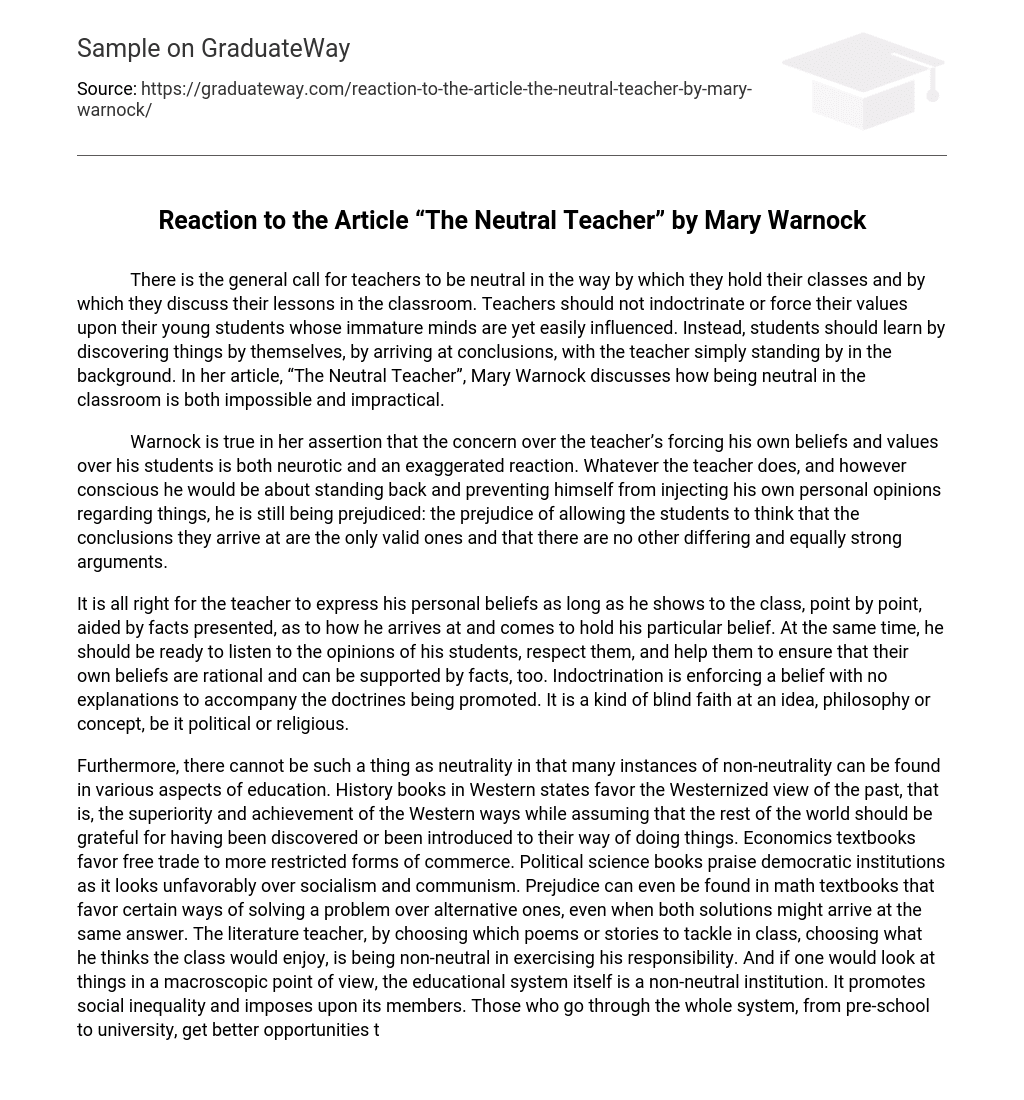There is the general call for teachers to be neutral in the way by which they hold their classes and by which they discuss their lessons in the classroom. Teachers should not indoctrinate or force their values upon their young students whose immature minds are yet easily influenced. Instead, students should learn by discovering things by themselves, by arriving at conclusions, with the teacher simply standing by in the background. In her article, “The Neutral Teacher”, Mary Warnock discusses how being neutral in the classroom is both impossible and impractical.
Warnock is true in her assertion that the concern over the teacher’s forcing his own beliefs and values over his students is both neurotic and an exaggerated reaction. Whatever the teacher does, and however conscious he would be about standing back and preventing himself from injecting his own personal opinions regarding things, he is still being prejudiced: the prejudice of allowing the students to think that the conclusions they arrive at are the only valid ones and that there are no other differing and equally strong arguments.
It is all right for the teacher to express his personal beliefs as long as he shows to the class, point by point, aided by facts presented, as to how he arrives at and comes to hold his particular belief. At the same time, he should be ready to listen to the opinions of his students, respect them, and help them to ensure that their own beliefs are rational and can be supported by facts, too. Indoctrination is enforcing a belief with no explanations to accompany the doctrines being promoted. It is a kind of blind faith at an idea, philosophy or concept, be it political or religious.
Furthermore, there cannot be such a thing as neutrality in that many instances of non-neutrality can be found in various aspects of education. History books in Western states favor the Westernized view of the past, that is, the superiority and achievement of the Western ways while assuming that the rest of the world should be grateful for having been discovered or been introduced to their way of doing things. Economics textbooks favor free trade to more restricted forms of commerce. Political science books praise democratic institutions as it looks unfavorably over socialism and communism. Prejudice can even be found in math textbooks that favor certain ways of solving a problem over alternative ones, even when both solutions might arrive at the same answer. The literature teacher, by choosing which poems or stories to tackle in class, choosing what he thinks the class would enjoy, is being non-neutral in exercising his responsibility. And if one would look at things in a macroscopic point of view, the educational system itself is a non-neutral institution. It promotes social inequality and imposes upon its members. Those who go through the whole system, from pre-school to university, get better opportunities than those who do not. There are also private schools for those who could afford them and prominent universities for those who have the intellectual and financial capacities to get into them. Going to these good schools ensure good futures for those who attend them. On the other hand, there are public schools in poor neighborhoods with inadequate facilities and poor teaching and whose graduates seldom make it in the corporate world. If these schools produce success stories, it is a big deal compared to success stories from those who attended the good schools. Furthermore, the school as an institution has rules and exacts obedience from both its faculty and students. These rules sometimes include teaching specific values and beliefs.
Finally, it is important to note Warnock’s statement that the first rule of teaching is sincerity. To be sincere means to be honest with what one, as teacher, imparts to the students who listen to him. A teacher can be overly moral if he wants to do so. He can be vocal about his personal values. He can be passionate about expressing his values. However, he cannot also be too subjective that he forgets how to respect the differences among people’s belief and value systems. To be non-neutral still means that the teacher should be able to show his students how he has arrived to his personal conclusions. This way, he also teaches the students to think for themselves, to explore on their own and conduct their own investigations, so that in the end, they would have the capability to judge whether they would believe what their teacher also believes or not.
Reference
Warnock, Mary. “The Neutral Teacher.”





